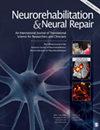中风后体力活动水平较高的个体显示出与健康老年人相似的髓鞘模式
IF 3.7
2区 医学
Q1 CLINICAL NEUROLOGY
引用次数: 3
摘要
背景髓鞘不对称率(MARs)与中风后的运动损伤和功能有关,并有助于其发挥作用。体育活动(PA)可能诱导髓鞘可塑性,有可能减轻中风后可能发生的半球髓鞘不对称。目的本研究的目的是确定PA水平较高的个体与PA水平较低的个体相比是否表现出较低的MAR。使用佩戴72小时(3天)的手腕加速计对活动水平进行量化。通过各组内的聚类分析确定较高和较低的PA水平。结果在老年组中,无论PA水平如何,MAR都是相似的。与PA较高的卒中组相比,PA较低的卒中参与者表现出更大的MAR。卒中组和老年人PA较高的组之间的MAR没有差异。在低PA组中,与老年人相比,中风患者的MAR更大。PA卒中组之间的手臂损伤、损伤体积、年龄、卒中后时间和优先使用手臂没有差异,这表明运动损伤的严重程度和脑损伤程度并没有导致PA的差异。一旦发生神经损伤,如中风,高水平的PA可能具有神经保护作用,并减轻髓鞘不对称。或者,中风后促进高水平的PA可能会减少髓鞘不对称。本文章由计算机程序翻译,如有差异,请以英文原文为准。
Individuals with Higher Levels of Physical Activity after Stroke Show Comparable Patterns of Myelin to Healthy Older Adults
Background Myelin asymmetry ratios (MARs) relate and contribute to motor impairment and function after stroke. Physical activity (PA) may induce myelin plasticity, potentially mitigating hemispheric myelin asymmetries that can occur after a stroke. Objective The aim of this study was to determine whether individuals with higher levels of PA showed lower MAR compared to individuals with lower levels of PA. Methods Myelin water fraction was obtained from 5 bilateral motor regions in 22 individuals with chronic stroke and 26 healthy older adults. Activity levels were quantified with wrist accelerometers worn for a period of 72 hours (3 days). Higher and lower PA levels were defined by a cluster analysis within each group. Results MAR was similar regardless of PA level within the older adult group. Compared to the higher PA stroke group, lower PA stroke participants displayed greater MAR. There was no difference in MAR between the stroke and older adult higher PA groups. Within the lower PA groups, individuals with stroke showed greater MAR compared to the older adults. Arm impairment, lesion volume, age, time since stroke, and preferential arm use were not different between the PA stroke groups, suggesting that motor impairment severity and extent of brain damage did not drive differences in PA. Conclusion Individuals who have had a stroke and are also physically active display lower MAR (i.e., similar myelin in both hemispheres) in motor regions. High levels of PA may be neuroprotective and mitigate myelin asymmetries once a neurological insult, such as a stroke, occurs. Alternately, it is possible that promoting high levels of PA after a stroke may reduce myelin asymmetries.
求助全文
通过发布文献求助,成功后即可免费获取论文全文。
去求助
来源期刊
CiteScore
8.30
自引率
4.80%
发文量
52
审稿时长
6-12 weeks
期刊介绍:
Neurorehabilitation & Neural Repair (NNR) offers innovative and reliable reports relevant to functional recovery from neural injury and long term neurologic care. The journal''s unique focus is evidence-based basic and clinical practice and research. NNR deals with the management and fundamental mechanisms of functional recovery from conditions such as stroke, multiple sclerosis, Alzheimer''s disease, brain and spinal cord injuries, and peripheral nerve injuries.

 求助内容:
求助内容: 应助结果提醒方式:
应助结果提醒方式:


